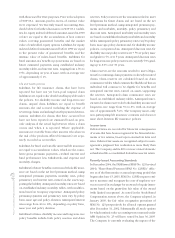American Express 2004 Annual Report Download - page 91
Download and view the complete annual report
Please find page 91 of the 2004 American Express annual report below. You can navigate through the pages in the report by either clicking on the pages listed below, or by using the keyword search tool below to find specific information within the annual report.
counterparty basis where management believes the
legal right of offset exists under enforceable netting
agreements. The accounting for the change in the fair
value of a derivative instrument depends on its
intended use and the resulting hedge designation,
if any.
Cash flow hedges
For derivative financial instruments that qualify as cash
flow hedges, the effective portions of the gain or loss
on the derivatives are recorded in accumulated other
comprehensive income (loss) and reclassified into
earnings when the hedged item or transactions impact
earnings. The amount that is reclassified into earnings
is presented in the income statement with the hedged
instrument or transaction impact, generally, in net
investment income or interest expense. Any ineffective
portion of the gain or loss is reported as a component
of other revenue. If a hedge is de-designated or termi-
nated prior to maturity, the amount previously
recorded in accumulated other comprehensive income
(loss) is recognized into earnings over the period that
the hedged item impacts earnings. For any hedge rela-
tionships that are discontinued because the forecasted
transaction is not expected to occur according to the
original strategy, any related amounts previously
recorded in accumulated other comprehensive income
(loss) are recognized into earnings immediately.
Fair value hedges
For derivative financial instruments that qualify as fair
value hedges, changes in the fair value of the deriva-
tives as well as of the corresponding hedged assets,
liabilities or firm commitments are recorded in earnings
as a component of other revenue. If a fair value hedge
is de-designated or terminated prior to maturity, previ-
ous adjustments to the carrying value of the hedged
item are recognized into earnings to match the earnings
pattern of the hedged item.
Net investment hedges in foreign operations
For derivative financial instruments that qualify as net
investment hedges in foreign operations, the effective
portions of the change in fair value of the derivatives
are recorded in accumulated other comprehensive
income (loss) as part of the cumulative translation
adjustment. Any ineffective portions of net investment
hedges are recognized in other revenue during the
period of change.
Non-designated derivatives and trading activities
For derivative financial instruments that do not qualify
for hedge accounting, are not designated under SFAS
No. 133 as hedges or are comprised of customer or
proprietary trading activities, changes in fair value are
reported in current period earnings generally as a
component of other revenue.
Derivative financial instruments that are entered into for
hedging purposes are designated as such at the time that
the Company enters into the contract. As required by
SFAS No. 133, for all derivative financial instruments that
are designated for hedging activities, the Company for-
mally documents all of the hedging relationships
between the hedge instruments and the hedged items at
the inception of the relationships. Management also for-
mally documents its risk management objectives and
strategies for entering into the hedge transactions. The
Company formally assesses, at inception and on a quar-
terly basis, whether derivatives designated as hedges are
highly effective in offsetting the fair value or cash flows
of hedged items. If it is determined that a derivative is
not highly effective as a hedge, the Company will dis-
continue the application of hedge accounting.
Insurance and annuity reserves
Fixed annuities and variable annuity guarantees
Liabilities for fixed and variable deferred annuities are
equal to accumulation values, which are the cumula-
tive gross premium payments, credited interest and
fund performance less withdrawals and expense and
mortality charges.
In addition, the majority of the variable annuity contracts
offered by AEFA contain guaranteed minimum death
benefit (GMDB) provisions. When market values of
the customers’ accounts decline, the death benefit
payable on a contract with a GMDB may exceed the
contract accumulation value. Other AEFA product offer-
ings include variable annuities with death benefit pro-
visions that gross up the amount payable by a certain
percentage of contract earnings (gain gross-up benefits)
and/or guaranteed minimum income benefit (GMIB)
provisions. Effective January 1, 2004, liabilities for these
variable annuity death and GMIB benefits have been
established under the American Institute of Certified
Public Accountants Statement of Position 03-1,
“Accounting and Reporting by Insurance Enterprises for
Certain Nontraditional Long-Duration Contracts and for
Separate Accounts” (SOP 03-1). Actuarial models to
simulate various equity market scenarios are used to
project these benefits and contract assessments and
include making significant assumptions related to cus-
tomer asset value growth rates, mortality, persistency
and investment margins. These assumptions, as well as
their periodic review by management, are consistent
AXP
AR.04
89
Notes to Consolidated Financial Statements
























